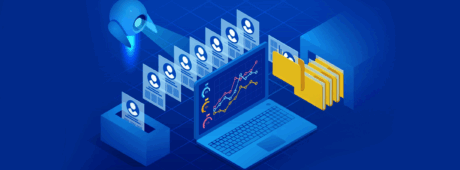Vibe Coding vs. Low-Code: Where Caspio Fits in the Future of Application Development
October 22, 2025

The way we build software is rapidly evolving, driven by AI, automation, and a shift toward more accessible application development frameworks. Two approaches in particular are drawing attention: vibe coding and low-code platforms. Both aim to democratize software development, but the differences in scalability, governance, and long-term usability are stark. Here’s how these two approaches compare, and where Caspio, a leading enterprise-grade low-code platform, fits into the future of digital transformation.
What Is Vibe Coding?
Vibe coding is a conversational approach to application development, emerging from the rise of AI copilots and natural language programming. Instead of writing lines of code, you describe your intent, “build me an expense tracker with a dashboard”, and the AI generates a working prototype.
The appeal is obvious: it’s conversational, fast, and feels almost magical. A non-developer can create something in minutes that would otherwise take hours or days.
But the tradeoffs are equally clear. AI-generated code can be a black box that’s difficult to maintain, debug, or scale. Governance and data security are afterthoughts, and success often depends on how clearly you can prompt the AI.
In short: vibe coding shines at rapid prototyping, but it struggles to deliver sustainable, enterprise-grade solutions.
What Is Low-Code Development?
Low-code development platforms like Caspio have been maturing for over two decades. These platforms offer drag-and-drop interfaces, visual workflows, and prebuilt components to accelerate development. They’re designed to let business professionals, often called “citizen developers”, build applications without needing to master traditional coding.
The benefits are proven: reliable frameworks, consistent governance, and built-in scalability. Low-code platforms aren’t as instantly gratifying as asking an AI to generate an app, but they deliver structured outcomes that organizations can depend on.
Of course, there is still a learning curve. Every platform has its own design patterns, and users must understand how to model their data and workflows. But once mastered, low code provides both speed and reliability.
Vibe Coding vs. Low Code: Key Differences
So how do these two approaches stack up against each other?
| Category | Vibe Coding | Low-Code Platforms (e.g., Caspio) |
|---|---|---|
| Prototyping Speed | Near-instant ideation with natural language prompts | Fast, but requires upfront planning and data modeling |
| Governance | Minimal; security and audit features are lacking | Built-in controls: HIPAA, GDPR, SOC 2, audit trails |
| Scalability | Typically one-off prototypes; hard to maintain or scale | Apps built on robust, scalable data architectures |
| Skill Level Needed | Designed for hobbyists and early-stage experiments | Empowers business pros and IT teams to deliver production-ready apps |
| Maintainability | Hard to extend or debug; AI output lacks consistency | Visual tools with structured logic, versioning, and long-term control |
Where Caspio Stands Out
Caspio offers a differentiated approach to low code, bridging the flexibility of rapid development with the discipline required for enterprise success.
- Database-First Foundation: At its core, Caspio is a powerful, scalable database engine. Every app you build sits on top of a solid data model.
- No-Code/Low-Code Hybrid: Non-technical users can build apps entirely through visual tools, while developers can extend functionality with custom logic.
- Enterprise Readiness: Caspio meets the compliance, security, and scalability demands of serious organizations, something vibe coding tools simply don’t offer today. If you’re exploring how low-code platforms like Caspio support enterprise-scale development, check out our in-depth guide: Low-Code for Enterprise Apps.
- 24/7 Support & Expertise: Unlike experimental AI tools, Caspio customers get around-the-clock live support. Businesses know that when they hit a roadblock, help is available instantly, a critical factor for uptime, customer success, and mission-critical apps.
- Professional Services & Partner Network: Organizations that want additional help can tap into Caspio’s in-house professional services team or a global partner network for specialized development. This ensures no project is too complex to deliver.
- Ready-to-Use Applications: Caspio offers a rich library of prebuilt applications that are fully functional out of the box yet easy to customize. This jumpstarts development, allowing teams to move from idea to production in days, not months.
- AI Opportunities: Rather than competing with vibe coding, Caspio has the opportunity to integrate it. Imagine brainstorming with AI in natural language, then translating those ideas into Caspio’s structured, enterprise-grade environment. Watch for these capabilities to be available in the near future.
The Future: Convergence, Not Competition
It’s tempting to frame vibe coding and low code as rivals, but the reality is more nuanced. They’re on a path toward convergence. Low-code platforms like Caspio are already experimenting with AI assistants that help design data models, generate workflows, or recommend user interface layouts. Meanwhile, vibe coding will need the structure and governance that low-code platforms already provide.
The sweet spot is clear: use vibe coding for ideation and rapid prototyping, then rely on low –code platforms like Caspio for sustainable delivery.
Conclusion
Vibe coding captures the imagination with its speed and creativity. Low code delivers the reliability and scale enterprises demand. Caspio merges both worlds with:
- A visual development experience
- Enterprise-level security and compliance
- AI-enhanced workflows
- Unlimited app users on every plan
- And best-in-class live human support
Caspio ensures that businesses don’t just build applications quickly, they build applications that scale, perform, and grow with their organization.
Start your free trial today and turn your ideas into powerful, production-ready applications your business can rely on.















